Choosing a Gaming CPU: Single + Multi-GPU at 1440p, April 2013
by Ian Cutress on May 8, 2013 10:00 AM ESTCPU Benchmarks
Point Calculations - 3D Movement Algorithm Test
The algorithms in 3DPM employ both uniform random number generation or normal distribution random number generation, and vary in amounts of trigonometric operations, conditional statements, generation and rejection, fused operations, etc. The benchmark runs through six algorithms for a specified number of particles and steps, and calculates the speed of each algorithm, then sums them all for a final score. This is an example of a real world situation that a computational scientist may find themselves in, rather than a pure synthetic benchmark. The benchmark is also parallel between particles simulated, and we test the single threaded performance as well as the multi-threaded performance.
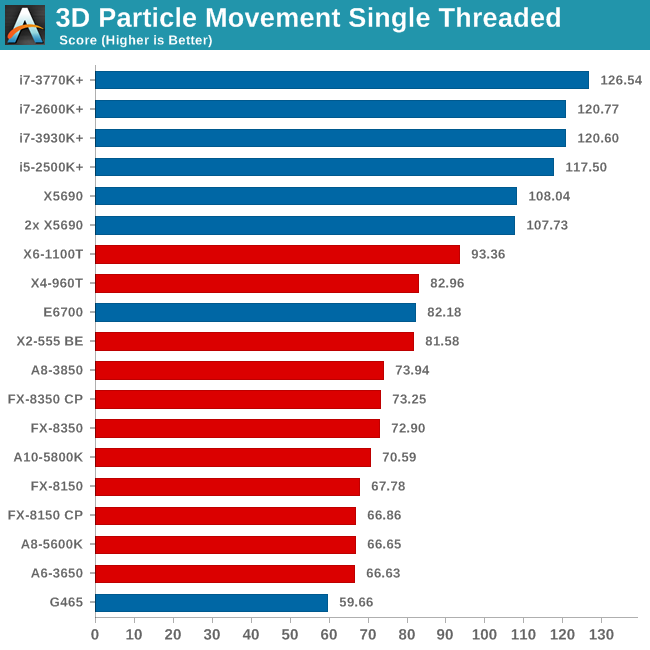
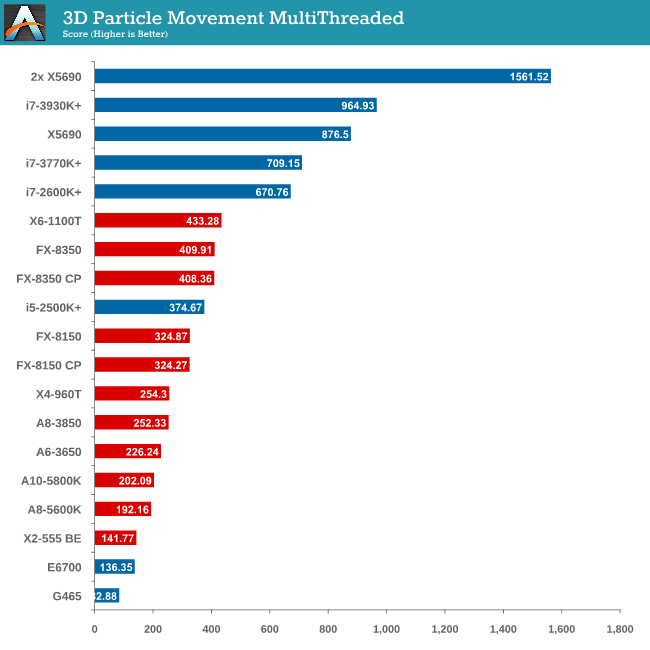
As mentioned in previous reviews, this benchmark is written how most people would tackle the situation – using floating point numbers. This is also where Intel excels, compared to AMD’s decision to move more towards INT ops (such as hashing), which is typically linked to optimized code or normal OS behavior.
Compression - WinRAR x64 3.93 + WinRAR 4.2
With 64-bit WinRAR, we compress the set of files used in our motherboard USB speed tests. WinRAR x64 3.93 attempts to use multithreading when possible and provides a good test for when a system has variable threaded load. WinRAR 4.2 does this a lot better! If a system has multiple speeds to invoke at different loading, the switching between those speeds will determine how well the system will do.
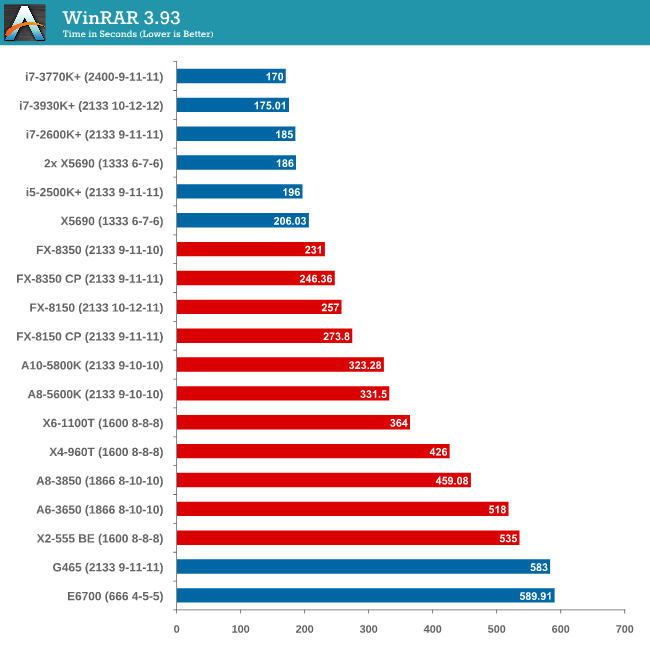

Due to the late inclusion of 4.2, our results list for it is a little smaller than I would have hoped. But it is interesting to note that with the Core Parking updates, an FX-8350 overtakes an i5-2500K with MCT.
Image Manipulation - FastStone Image Viewer 4.2
FastStone Image Viewer is a free piece of software I have been using for quite a few years now. It allows quick viewing of flat images, as well as resizing, changing color depth, adding simple text or simple filters. It also has a bulk image conversion tool, which we use here. The software currently operates only in single-thread mode, which should change in later versions of the software. For this test, we convert a series of 170 files, of various resolutions, dimensions and types (of a total size of 163MB), all to the .gif format of 640x480 dimensions.
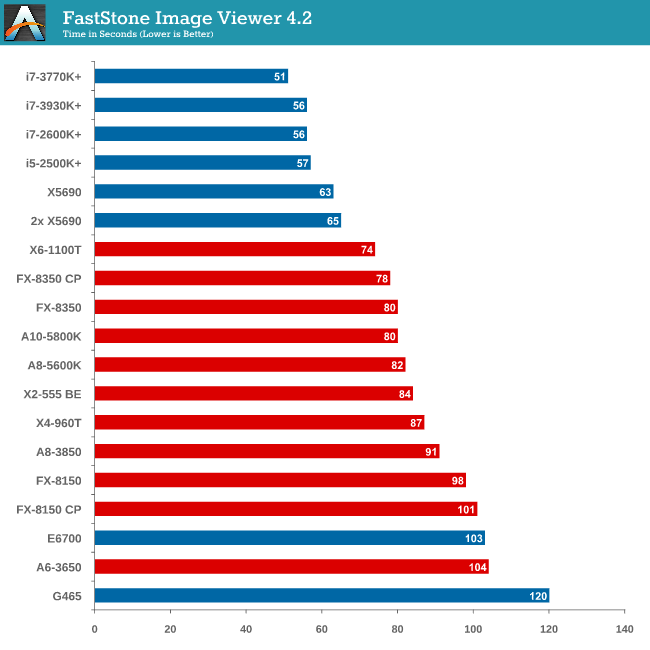
In terms of pure single thread speed, it is worth noting the X6-1100T is leading the AMD pack.
Video Conversion - Xilisoft Video Converter 7
With XVC, users can convert any type of normal video to any compatible format for smartphones, tablets and other devices. By default, it uses all available threads on the system, and in the presence of appropriate graphics cards, can utilize CUDA for NVIDIA GPUs as well as AMD WinAPP for AMD GPUs. For this test, we use a set of 33 HD videos, each lasting 30 seconds, and convert them from 1080p to an iPod H.264 video format using just the CPU. The time taken to convert these videos gives us our result.
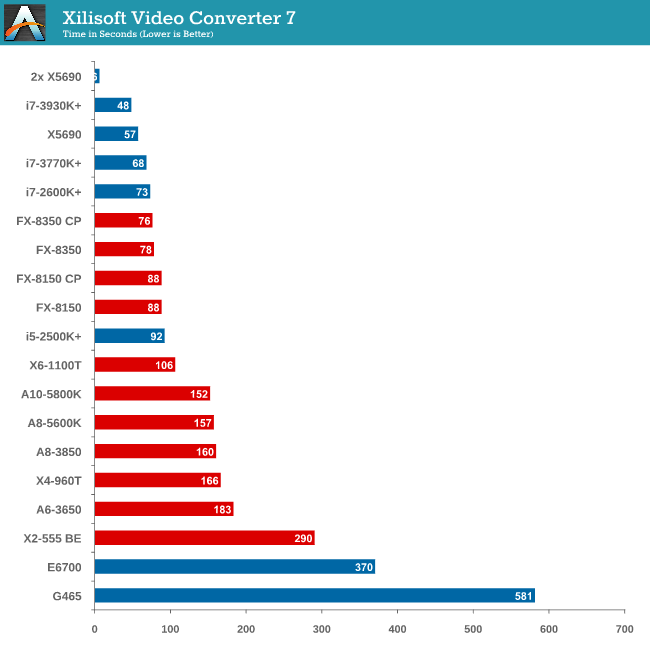
XVC is a little odd in how it arranges its multicore processing. For our set of 33 videos, it will arrange them in batches of threads – so if we take the 8 thread FX-8350, it will arrange the videos into 4 batches of 8, and then a fifth batch of one. That final batch will only have one thread assigned to it (!), and will not get a full 8 threads worth of power. This is also why the 2x X5690 finishes in 6 seconds but the normal X5690 takes longer – you would expect a halving of time moving to two CPUs but XVC arranges the batches such that there is always one at the end that only gets a single thread.
Rendering – PovRay 3.7
The Persistence of Vision RayTracer, or PovRay, is a freeware package for as the name suggests, ray tracing. It is a pure renderer, rather than modeling software, but the latest beta version contains a handy benchmark for stressing all processing threads on a platform. We have been using this test in motherboard reviews to test memory stability at various CPU speeds to good effect – if it passes the test, the IMC in the CPU is stable for a given CPU speed. As a CPU test, it runs for approximately 2-3 minutes on high end platforms.
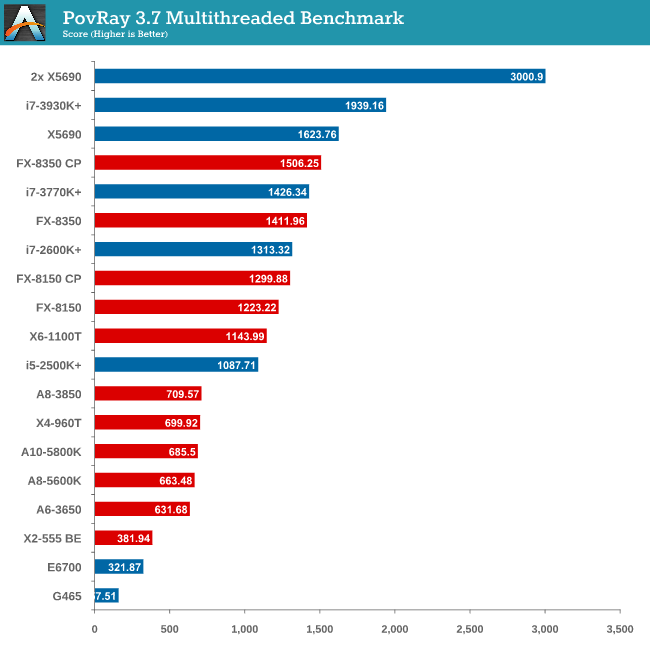
The SMP engine in PovRay is not perfect, though scaling up in CPUs gives almost a 2x effect. The results from this test are great – here we see an FX-8350 CPU below an i7-3770K (with MCT), until the Core Parking updates are applied, meaning the FX-8350 performs better!
Video Conversion - x264 HD Benchmark
The x264 HD Benchmark uses a common HD encoding tool to process an HD MPEG2 source at 1280x720 at 3963 Kbps. This test represents a standardized result which can be compared across other reviews, and is dependent on both CPU power and memory speed. The benchmark performs a 2-pass encode, and the results shown are the average of each pass performed four times.
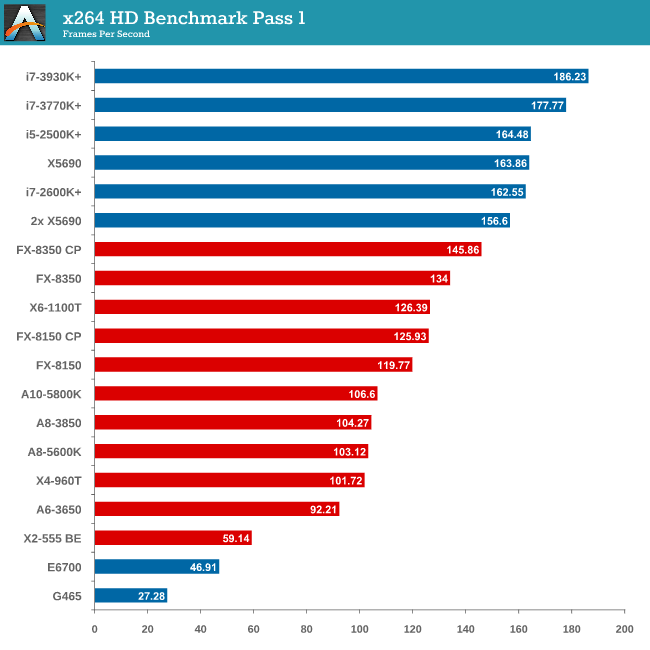
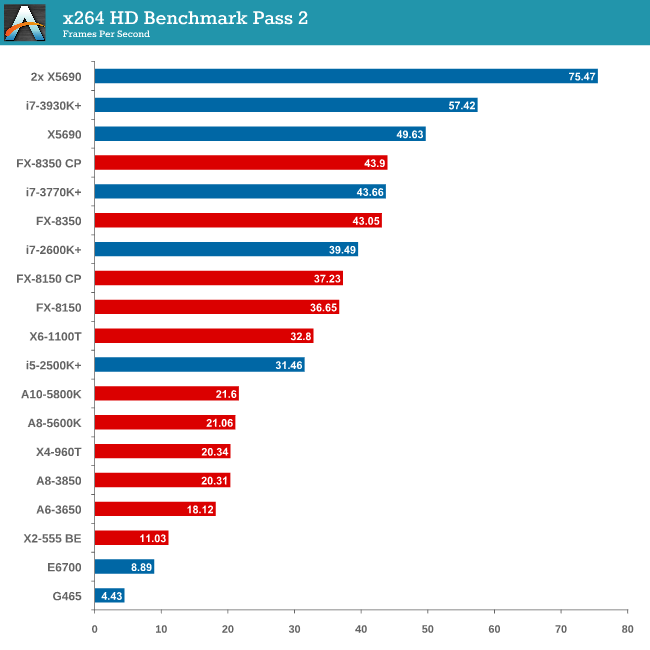
Grid Solvers - Explicit Finite Difference
For any grid of regular nodes, the simplest way to calculate the next time step is to use the values of those around it. This makes for easy mathematics and parallel simulation, as each node calculated is only dependent on the previous time step, not the nodes around it on the current calculated time step. By choosing a regular grid, we reduce the levels of memory access required for irregular grids. We test both 2D and 3D explicit finite difference simulations with 2n nodes in each dimension, using OpenMP as the threading operator in single precision. The grid is isotropic and the boundary conditions are sinks. Values are floating point, with memory cache sizes and speeds playing a part in the overall score.
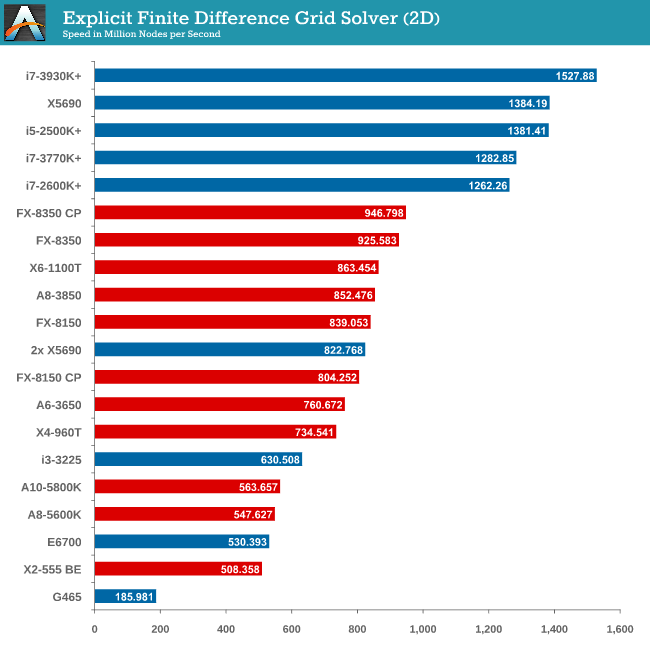
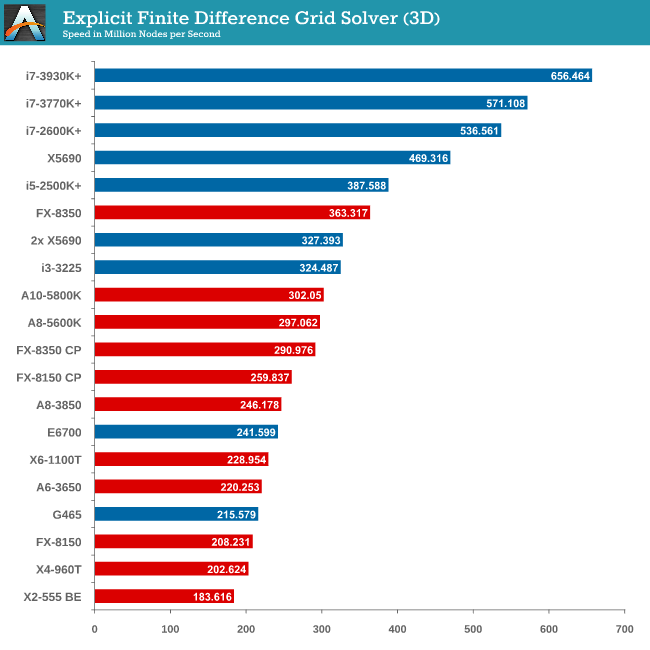
Grid solvers do love a fast processor and plenty of cache in order to store data. When moving up to 3D, it is harder to keep that data within the CPU and spending extra time coding in batches can help throughput. Our simulation takes a very naïve approach in code, using simple operations.
Grid Solvers - Implicit Finite Difference + Alternating Direction Implicit Method
The implicit method takes a different approach to the explicit method – instead of considering one unknown in the new time step to be calculated from known elements in the previous time step, we consider that an old point can influence several new points by way of simultaneous equations. This adds to the complexity of the simulation – the grid of nodes is solved as a series of rows and columns rather than points, reducing the parallel nature of the simulation by a dimension and drastically increasing the memory requirements of each thread. The upside, as noted above, is the less stringent stability rules related to time steps and grid spacing. For this we simulate a 2D grid of 2n nodes in each dimension, using OpenMP in single precision. Again our grid is isotropic with the boundaries acting as sinks. Values are floating point, with memory cache sizes and speeds playing a part in the overall score.
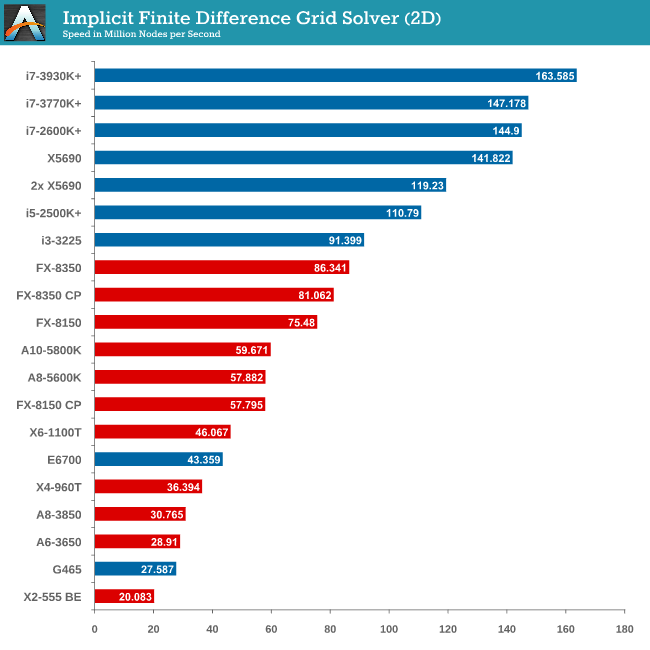
2D Implicit is harsher than an Explicit calculation – each thread needs more a lot memory, which only ever grows as the size of the simulation increases.
Point Calculations - n-Body Simulation
When a series of heavy mass elements are in space, they interact with each other through the force of gravity. Thus when a star cluster forms, the interaction of every large mass with every other large mass defines the speed at which these elements approach each other. When dealing with millions and billions of stars on such a large scale, the movement of each of these stars can be simulated through the physical theorems that describe the interactions. The benchmark detects whether the processor is SSE2 or SSE4 capable, and implements the relative code. We run a simulation of 10240 particles of equal mass - the output for this code is in terms of GFLOPs, and the result recorded was the peak GFLOPs value.
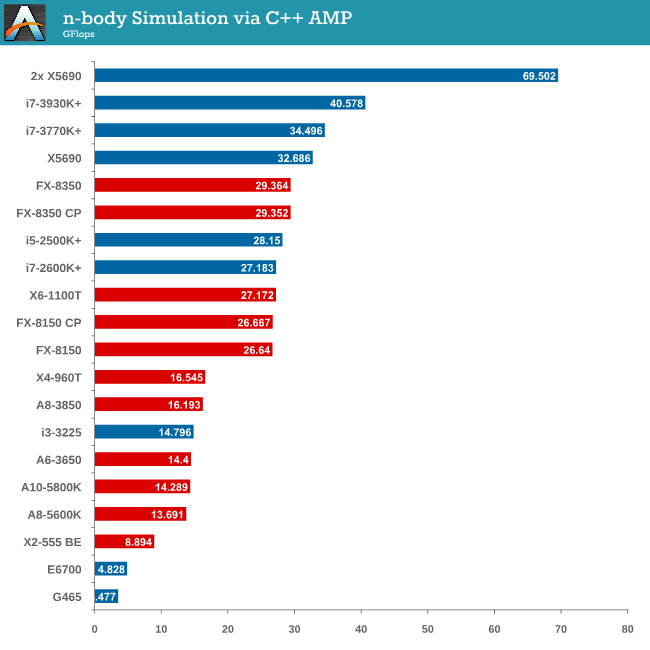
As we only look at base/SSE2/SSE4 depending on the processor (auto-detection), we don’t see full AVX numbers in terms of FLOPs.










242 Comments
View All Comments
Achaios - Friday, May 10, 2013 - link
@Ian Cutress: Hello Ian, please get a hold on a Quad Core Intel Core 2 CPU (q9540, q9550, q9650, qx9650, qx9770) and include it in your testing. I don't know where you get that "many people are still on Core 2 Duos" maybe you have seen some sort of market research? I still use a QX 9650 for gaming (WoW and SW:TOR-MMO's) and I am very happy with its performance. It would be nice to see how the high-end Core 2 CPUs measure up against modern CPUs.Andy_1 - Friday, May 10, 2013 - link
What a great Article, As I am in the process of making my mind up what to buy in the next two months this answers so many of my questions. Thank you! My main unanswered question some how seemed to get missed OR did I not read correctly??QThe results on the games show the 2 CPU config as scoring zero! is that because the wouldn't run the software on the rig or what?
ajlueke - Friday, May 10, 2013 - link
Great article. For those of us still gaming at 1080p with single GPU set ups, it is nice to know that it doesn't really matter if I spend a little less on the CPU and divert those funds toward a higher end GPU.Gamer4Life63 - Friday, May 10, 2013 - link
First, well done piece with lots of great info. Now then I would love to see this same kind of look done at 1080 resolutions with a mid range card like a 7870 or 7850. Would also love to see some other games added to the mix like a modern MMO or Skyrim that is a bit harder on the CPU.SurrenderMonkey - Friday, May 10, 2013 - link
Yes, Intel has great engineers not to forget the business gurus. Intel did a great job on Larrabee, choose(?) not to be in the Nextgen consoles and it will be jam tomorrow in the tablet and smartphone market. In April Intel reported a downturn of 25% in profits which it attributed to a decline on the PC market. As Anandtech has just shown the GPU is where the money is at, the CPU is a passenger and time to replace is extending. Intel makes good processors but it is also a one trick pony who has failed to move with the times.MarcVenice - Friday, May 10, 2013 - link
You thought of some many things to consider, yet when you say: We know what's missing, you forgot so many things. I didn't read all the comments so excuse me if someone already mentioned it. But what's missing is several games. Crysis 3 for example, or Far Cry 3.You mentioned that 1440p is a niche (it's 2560x1440 btw, 1440p isn't technically a resolution). So why didn't you test at 1920x1080, not only are games more prone to being cpu-limited, but games like Crysis 3 or Far Cry 3 are actually more demanding then games like DiRT 3.
Reason I mention this, is that I've found there to be a rather big difference between a X4 970 and a 3960X in those games, at ultra settings in Crysis 3 and FC3, with a GTX 660, 670 and 680. I know Anandtech doesn't report minimum's, but if you take the time to do as many runs as you did, you can scientifically establish that the minimum fps is also greatly affected by slower cpu's.
Reason I respond after not having done so in years, is that I found your suggestion to pare a 5600K with a high-end gpu to be disputable, and that's me being mild. Especially since you more or less went and said that 'other' websites or testing didn't do their testing properly.
OwnedKThxBye - Monday, May 13, 2013 - link
I agree 100% MarcVenice.The recommendation also doesn't take into consideration the upgrade path of the PC. If you were to follow this suggestion, the probability of having to do a full CPU and motherboard upgrade instead of just the GPU when you next need to upgrade is going to be significantly higher. Most people don't want to do a full system upgrade after 2-3 years because they are CPU limited on the new title they want to play. I say spend the extra $100-$150 on a better CPU and potentially make the PC last another two years.
lesherm - Friday, May 10, 2013 - link
Ian, this is real research and journalism. This kind of in-depth reporting on hardware is exactly what keeps me coming back to anandtech, year after year. Your efforts are appreciated!TheQweaker - Saturday, May 11, 2013 - link
I agree with this.-- The Qweaker.
Animebando - Friday, May 10, 2013 - link
I would love to see this kind of write-up that covers surround/eyefinity resolutions. I've been fairly impressed with how my 7950 handles games across three monitors, and I've been an nVidia fan for years.